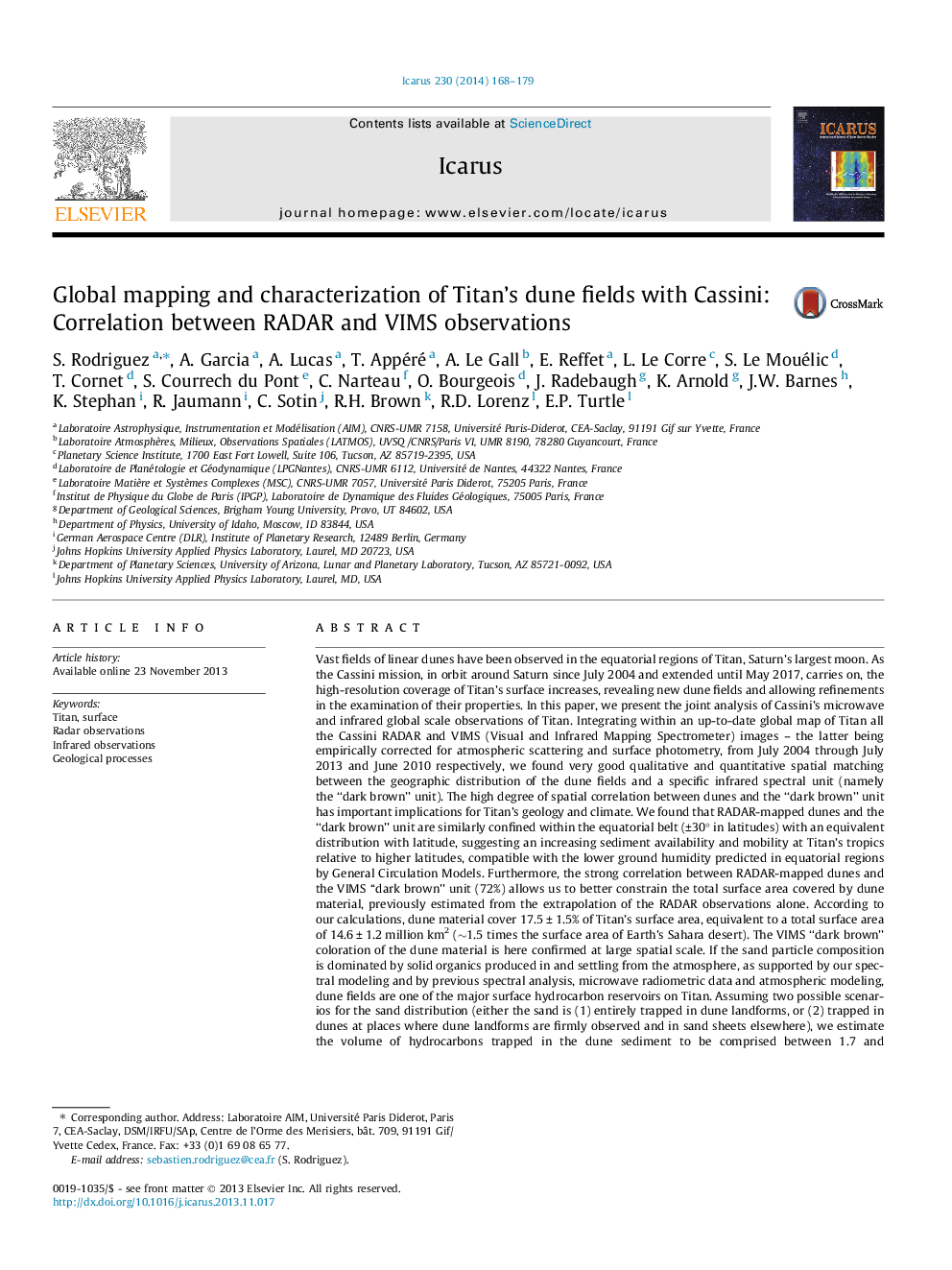| کد مقاله | کد نشریه | سال انتشار | مقاله انگلیسی | نسخه تمام متن |
|---|---|---|---|---|
| 1773153 | 1523560 | 2014 | 12 صفحه PDF | دانلود رایگان |

• Titan’s dunes have been mapped at global scale with RADAR and VIMS on board the Cassini spacecraft.
• Excellent correlation has been found at the global scale between RADAR-mapped dunes and the VIMS dark brown unit.
• Dune material is dominated by solid organics of atmospheric origin.
• Dune material covers 17% of Titan’s surface, corresponding to a total average mass of organic sediment of ∼230,000 GT.
• Dunes are the largest visible surface reservoir of hydrocarbons and may be less than 730-Myr old.
Vast fields of linear dunes have been observed in the equatorial regions of Titan, Saturn’s largest moon. As the Cassini mission, in orbit around Saturn since July 2004 and extended until May 2017, carries on, the high-resolution coverage of Titan’s surface increases, revealing new dune fields and allowing refinements in the examination of their properties. In this paper, we present the joint analysis of Cassini’s microwave and infrared global scale observations of Titan. Integrating within an up-to-date global map of Titan all the Cassini RADAR and VIMS (Visual and Infrared Mapping Spectrometer) images – the latter being empirically corrected for atmospheric scattering and surface photometry, from July 2004 through July 2013 and June 2010 respectively, we found very good qualitative and quantitative spatial matching between the geographic distribution of the dune fields and a specific infrared spectral unit (namely the “dark brown” unit). The high degree of spatial correlation between dunes and the “dark brown” unit has important implications for Titan’s geology and climate. We found that RADAR-mapped dunes and the “dark brown” unit are similarly confined within the equatorial belt (±30° in latitudes) with an equivalent distribution with latitude, suggesting an increasing sediment availability and mobility at Titan’s tropics relative to higher latitudes, compatible with the lower ground humidity predicted in equatorial regions by General Circulation Models. Furthermore, the strong correlation between RADAR-mapped dunes and the VIMS “dark brown” unit (72%) allows us to better constrain the total surface area covered by dune material, previously estimated from the extrapolation of the RADAR observations alone. According to our calculations, dune material cover 17.5 ± 1.5% of Titan’s surface area, equivalent to a total surface area of 14.6 ± 1.2 million km2 (∼1.5 times the surface area of Earth’s Sahara desert). The VIMS “dark brown” coloration of the dune material is here confirmed at large spatial scale. If the sand particle composition is dominated by solid organics produced in and settling from the atmosphere, as supported by our spectral modeling and by previous spectral analysis, microwave radiometric data and atmospheric modeling, dune fields are one of the major surface hydrocarbon reservoirs on Titan. Assuming two possible scenarios for the sand distribution (either the sand is (1) entirely trapped in dune landforms, or (2) trapped in dunes at places where dune landforms are firmly observed and in sand sheets elsewhere), we estimate the volume of hydrocarbons trapped in the dune sediment to be comprised between 1.7 and 4.4 × 105 km3, corresponding to an average total mass of 230,000 GT, in comparison with ∼4000–30,000 GT of hydrocarbons in the polar lakes and seas. This indicates a maximum age for the dune sediments of ∼730-Myr, consistent with estimations of the ages of the current Titan’s atmospheric methane and surface.
Journal: Icarus - Volume 230, 15 February 2014, Pages 168–179